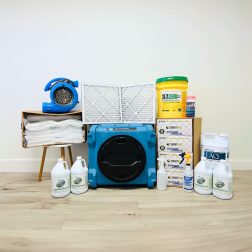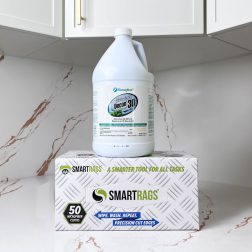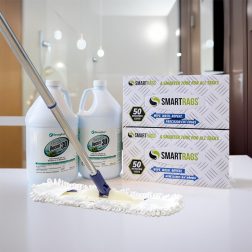No products in the cart.
While the exterior of homes are typically made of lumber, concrete, steel, stone, and brick, one main component is found inside almost all of the buildings in America: drywall. This porous material became all the rage in the 40s and 50s thanks to being noncombustible, durable, easy to install, and, most importantly, cheap. Yet, even with all of its perks, there is a downside. Mold on drywall can happen in the blink of an eye and turn the material into an indoor air quality hazard.
Drywall is used throughout a home’s interior to create walls, ceilings, eaves, and arches. As a result, mold on drywall can occur pretty much anywhere inside your home. That’s why one of the main issues we at HomeCleanse see our clients facing is this contaminated material.
Whether you’re facing a microbial growth situation now or want to prepare in case mold on drywall occurs, here is everything you need to know to handle the problem successfully. That way, you’ll have peace of mind that there isn’t a silent source of contamination, tanking your indoor air quality and causing unwanted exposures.
Why Does Mold on Drywall Develop?
Once present in a home, mold spores need two main elements to grow and spread: water and a food source. Nearly any organic substance, including paper, cloth, wood, plant material, or soil, can serve as a food source for mold.
Drywall is an incredibly common building material used in the interiors of approximately 95% of U.S. homes today. The most common type of drywall is gypsum board. This drywall consists of gypsum, a natural crystalline mineral, pressed between two layers of specially designed paper. This paper can serve as the perfect organic food source for mold.
That leaves moisture. Condensation from high humidity, a leak, or flooding are a few common examples of how this material can get wet. Going back to the amount of this material in a home, it’s easy to see how mold on drywall can pop up.
How Long Does It Take For Mold to Grow on Wet Drywall?
One of the main concerns with mold is that it grows quickly. All it takes is 24-48 hours for mold to grow on a wet surface with organic material.
That means if drywall is wet for a day or two, a contamination situation can pop up. That’s why time is always of the essence when dealing with any sort of water-related event in a home. The sooner you can get the material dried out, the less opportunity for microbial growth to develop.
Is Mold on Drywall Dangerous?

The simple answer is yes. As soon as mold grows, it releases spores, fragments, and potentially toxins into the surrounding environment. To further complicate the matter, bacteria grow in similar conditions and release microscopic particles as well, lowering the air quality even more. The size of these particles makes them so impactful to our health. They’re small enough to be inhaled, absorbed, and ingested into the body. Some are so small that they can bypass our lungs and go straight into the bloodstream.
As mold exists relatively everywhere, it’s impossible not to encounter a few spores, particles, and toxic byproducts throughout the day. Typically, this doesn't cause a problem. The body’s immune system will deploy and get rid of them ASAP.
When living with an active source of mold indoors, though, your body isn’t just facing a couple of particles daily; it’s facing an entire army every time you’re inside. Standing inside a contaminated bubble is a much bigger task and can lead to the immune system getting overrun and malfunctioning, triggering many symptoms. Mold toxicity can also work with other autoimmune conditions like Lyme, Candida, and CIRS to cause further harm to the body.
Some symptoms of mold exposure include:
- Runny nose
- Rashes
- Hair loss
- Neurological issues
- Mood swings
- Watery eyes
- Cough
- Digestive problems
- Chronic fatigue
- Brain fog
- Respiratory issues
The tricky thing about exposure is that no two experiences are the same. Factors such as genetics, preexisting conditions, species of mold, presence of mycotoxins, immune system status, and volume of exposure all play a role. They do know that individuals with compromised or developing immune systems are at greater risk of developing symptoms faster and to a greater extent.
While some species of mold are naturally toxic and others can produce mycotoxins, they all have the potential to impact health. This potential impact is enough reason to avoid as much exposure as possible, including mold on drywall.
What Does Mold on Drywall Look Like?

With so many species existing in the world, mold colonies can come in a variety of colors, shapes, and textures. Some of the most common colors include green, white, grey, blue, red, black, brown, or a combination of them. As for textures, they could be fuzzy, powdery, velvety, or slimy.
If any type of unidentifiable growth pops up, it's safe to assume there’s mold on
Other Signs of Mold on Drywall
Don’t just rely on visibility, though. Sometimes, mold can be hidden behind walls or underneath flooring. In that case, pay attention to these other indicators as well.
1. Water Damage
Signs of water damage mean that mold had a moisture-rich opportunity to grow. You may not see visible growth yet, but that doesn’t mean there isn’t a problem. The colony could be in its early life stages or growing on the other side of the surface.
That’s why water-damaged areas should be treated as if contaminants are already present.

Signs to look out for include:
- Bubbling, cracking, or peeling paint
- Coffee-like stains and discoloration
- Condensation droplets
- Drooping or warping of the surface
2. Odor
If you don’t find any visible issues, that doesn’t mean there isn’t a problem. It’s also important to rely on your nose.
Mold growth often creates a damp, musty, earthy smell due to the release of gases called microbial volatile organic compounds (MVOC). If you smell this, you may be dealing with a contamination situation.
3. Chronic Health Issues
Our bodies are incredible warning systems that will alert us if something’s wrong, including a contaminant in our indoor environments. It’s up to us to listen to these signals and figure out the root cause so that it can be eliminated.
If chronic symptoms suddenly appear and worsen near specific parts of the home, this can be your body’s way of saying, “Hey, something is not right here.”
How to Remove Mold on Drywall
If mold on drywall pops up in your home, do not just throw some bleach on it. That will not solve your indoor air quality issue. The best route is to hire professionals to come in and resolve the problem. Successful remediation is difficult because of the drywall’s porosity and ability to grow behind the surface onto the home's foundation.
To handle the problem, all of the contamination must be removed so that exposure does not continue. That includes the roots that grew into the surface, spores, fragments, mycotoxins, and bacteria. Porous materials like drywall should be removed and replaced because getting all the contamination off the surface is impossible.
It’s also difficult to determine the extent of the contamination. How deep does the contamination go? Has it led to other issues developing elsewhere in the home?
Hiring professionals will help ensure your home becomes safe and the contamination situation is fully handled. The good news is that replacing impacted drywall is relatively cheap once the space has been appropriately remediated and cleaned.
Finding a Mold Inspector

The first step should be to hire a qualified mold inspector. This individual sets the foundation for success in properly handling a contamination situation. All the data they collect will help create a comprehensive protocol for the remediation team to handle the problem appropriately. Not all mold inspectors are created equal, so choose the right person.
The chosen individual should spend at least a few hours combing through the interior and exterior of the home using various methodologies.
Hiring a Remediation Team
After the inspector collects data, your next step is to find a qualified remediation company like HomeCleanse to remove the mold on the bathroom ceiling. Like mold inspectors, though, not all remediation teams are built the same.
You want a company that prioritizes your health, understands the importance of creating a safe environment, and has proven successful in remediating toxic homes. Their protocol should be built on three main pillars to ensure proper decontamination.
These three pillars are:
- Remediate the sources properly.
- Identify and address the problems that led to those sources in the first place.
- Eradicate all contamination created by those sources, including toxins and bacteria.
Failure to hit every point is an unsuccessful remediation.
If the source that led to the contamination isn’t addressed, the conditions for growth are still there, allowing the problem to come right back. Should the roots of the microbial growth be left behind, the colony can come right back. High levels of contaminants like mycotoxins and bacteria left behind can lead to continued exposure. Each scenario does not lead to a healthy home environment and can allow chronic symptoms to persist.
The last thing anyone wants to do is waste money and time repeating the process while continuing to feel ill. The right team should check all the above boxes so that when they leave, you can rest easy knowing that the mold on drywall is no longer an issue.
Determined To Try It On Your Own?
If you want to attempt a remediation project, proceed cautiously and only work on areas under 10 square feet. Contacting an expert beforehand can give you a full breakdown of how to address the issue properly.
Things to keep in mind:
- Use correct engineering controls and put PPE in place
- The source that led to the growth needs to be resolved
- All porous materials, like drywall, need to be removed and replaced
- All surfaces need to be decontaminated using the proper remediation protocols based on the specific surface type
- The surrounding space should be deeply cleaned to remove any particles released by the active growth
If you aren’t confident that you can tick off each box, the professional route is the way to ensure all the contamination is removed.
-

HomeCleanse DIY
All the equipment and materials we use to remediate your home, plus consultation and support...
-
$5,995.00 – $9,995.00 SHOP NOW -

Mold & Bacteria Contents Cleaning
Remove harmful pollutants that accumulate in the dust of your home. (Options available for renters...
-
$99.00 – $349.00 SHOP NOW -

HomeCleanse Cleaning
Take your cleaning to the next level buying all the tools we use to keep...
-
$299.00 – $549.00 SHOP NOW
How to Prevent Mold on Drywall
The best way to deal with mold on drywall is to prevent it from occurring in the first place! That way, the contamination never has the opportunity to impact your indoor air quality, and you save money from costly remediation and inspections.
There are a plethora of ways you can work to avoid this issue. Your main goals will be to decrease moisture and eliminate microscopic particles.
Ways to prevent mold on drywall include:
- Control humidity. Maintain indoor humidity levels between 35% and 50%.
- Reduce moisture. Mold can grow in as little as 24-48 hours if the surface has a source of moisture and food. To eliminate this opportunity, work to avoid moisture as much as possible. This can include:
- Cleaning up spills and pooled water ASAP
- Hanging up wet items to dry, such as the bathmat and towels
- Avoiding leaving wet clothes in the laundry
- Separating the shower curtain and liner so that they can dry after use
- Allowing appliances to dry out after use (ex: leaving the dishwasher door open after unloading)
- Squeegee the shower after use
- Regularly check for structural issues in the shower, such as misaligned tiles and aging grout, and resolve any issues immediately so that they don’t trap moisture
- Fixing leaks
- Maintaining an indoor humidity level of 35 to 50% because some species of mold can grow in humidity of 60% and higher
- Crack a door or window and turn on the exhaust fan while showering. If the humidity in the bathroom doesn’t lower to the right level, consider investing in a dehumidifier for the room.
- Wash porous materials like bath mats, towels, bedding, shower liners, blankets, curtains, and anything else machine-washable with a botanical laundry additive like EC3.
- Don’t leave doors and windows open on humid and/or rainy days to help maintain indoor humidity levels.
- Make sure that landscape grading slopes down and away from the home in all directions to help divert water from the home so that it doesn’t pool near the foundation.
- Regularly check the gutters to ensure they’re clean, have no damage, and are installed properly.
- Schedule an HVAC professional to service the machine bi-annually to ensure there is no contamination in the system and that it is running properly.
- Invest in air purification with the technology to remove the smallest particles possible. The fewer small particles inside, the healthier the indoor air quality and the less likely microbial growth will develop.
- Upgrade to the highest-rated MERV filters that the HVAC system can handle and change them on time. This will help eliminate small particles like mold spores so that they don’t continue to build up inside.
- Regularly check for water damage and address issues within 24 hours.
- Address any structural issues with the home immediately
- Ensure that windows and doors are properly sealed to keep moisture out.
- When painting drywall, use paint that contains mold inhibitors.
- Regularly inspect drywall, especially in areas prone to moisture, for signs of mold growth, discoloration, or musty odors.
- Ensure attics and crawl spaces are well-ventilated to reduce the risk of moisture buildup.
Collectively, these will help you avoid mold on drywall and promote healthier indoor air quality.
Choosing The Right Material

Lastly, not all drywalls are created equal. If you’re building or renovating a home, picking the right drywall can help avoid future problems.
Standard drywall, or white board, is found on most ceilings and walls. This is the simplest and cheapest drywall option and offers no special moisture and mold resistance benefits. Green board is similar to whiteboard except that the paper backing on either side has an application of wax that makes this drywall more moisture-resistant. Purple board offers even greater resistance to moisture by utilizing 100% recycled paper as a backing. This creates greater protection than green board, but at a higher price.
Walls and ceilings installed in areas with high moisture potential, such as bathrooms and kitchens, should use green board at a minimum to help protect from moisture intrusion and mold growth. Special considerations must be made when walls are tiled and applied directly to standard drywall or green board, which will likely result in moisture intrusion. And where they’re moisture, there’s a potential for microbial growth. Opting for the best material now to avoid future problems is an investment for your home and your health.
Your Healthy Home
At the end of the day, our homes should be our oasis away from the world. But with modern building practices pushing for net zero energy efficiency, there’s very little airflow between indoor and outdoor environments. That means it’s up to us to help keep our indoor air quality in good shape so that it supports our health and doesn’t cause harmful exposures.
Preventing contamination on one of the most common materials in your home and actively knowing how to deal with mold on drywall will set you up for breathing easier.
